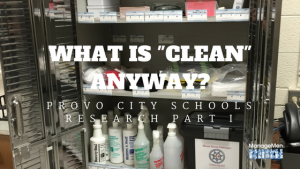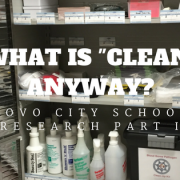Provo City Schools Research Part I: What is “Clean,” Anyway?

Many building owners and managers don’t realize that the cost to clean a building over its lifetime will nearly equal the cost of its original construction. When you think about it, that’s pretty mind-blowing. Yet while construction materials and practices have evolved to improve efficiency and bring costs down, most schools are still using the same cleaning practices used 80-plus years ago.
We’ll be the first to say that using the proper cleaning products, tools and practices is important in any type of facility, but schools are particularly important because of their potential impact on student performance and health. In this three-part series, we’ll examine just how important of a role that cleaning plays in a school—specifically, an old K-12 school in Provo, UT. Using Dr. Jeffrey Campbell’s two-year research study entitled “The Clean Schools Initiative: Provo City School District” as a guide, we’ll look at the following:
- How cleanliness is assessed and measured.
- How the performance of cleaning personnel is evaluated.
- How cleaning impacts indoor air quality.
- How a standardized approach to cleaning can transform a school by improving morale, saving money and creating a healthier, more productive indoor environment.
Ready?
How do we define “clean”?
Surprisingly, not one generally accepted definition of “clean” exists. This leads to broad discrepancies in how we clean. For example, some facilities clean for health (e.g. cleaners in healthcare clean to remove potentially harmful viruses and bacteria), and others clean for appearance (e.g. cleaners in a retail setting may clean to remove fingerprints and smudges from glass doors and display cases). But in order to identify how we should clean, we need to first identify what “clean” is and what it can achieve—so it’s a pretty critical piece of the puzzle.
In the book Protecting the Built Environment: Cleaning for Health, author Dr. Michael Berry writes, “cleaning is not only an activity, but a process and special form of management.”
Dr. Berry has conducted extensive research around the topic, looking at how cleaning impacts the educational performance of students and teachers. In particular, his study of the Charles Young Elementary School in Washington D.C. analyzed student performance before and after the building was remodeled and a higher standard of maintenance and cleanliness was implemented. His research revealed a strong correlation between the quality of of the physical school and quality of learning.
So if cleaning can have such positive outcomes (health, productivity and others), shouldn’t we also consider that in the definition?
Dr. Campbell proposes the following:
“Cleaning is a process that locates, identifies, contains, removes and properly disposes of an unwanted substance from a surface or environment, and contributes to the health and well-being of those who occupy the environment.”
By identifying a single commonly accepted definition of clean, we can start to streamline the processes that get us to that desired result.
How would you define clean? If it were a standardized process, do you feel that would allow us to better achieve the desired outcome of consistently “clean” environment?
In the next part of our series, we’ll look at how discrepancies in measurement of janitorial productivity and why clean matters—specifically in schools.

